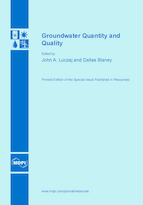Groundwater Quantity and Quality
A special issue of Resources (ISSN 2079-9276).
Deadline for manuscript submissions: closed (15 April 2015) | Viewed by 102492
Special Issue Editors
Interests: many aspects of hydrogeology, geochemistry, and sedimentology, including groundwater quality; stable isotopes; fluid-inclusion microthermometry; Mississippi-Valley-Type (MVT) mineralization; carbonate diagenesis; karst geology; field geology; Earth history; geology of Wisconsin and Michigan
Special Issues, Collections and Topics in MDPI journals
Special Issue Information
Dear Colleagues,
Groundwater is an essential component of the water cycle and is a critical resource for much of the world’s population. On a planet where demand for groundwater and other resources is ever increasing, issues of groundwater quantity and quality are a major focus in many regions of the world.
This Special Issue will provide an overview of topics that focus on either groundwater quantity or quality issues that are relevant on regional or national scales. Examples of groundwater quantity issues include long-term groundwater sustainability, interactions between groundwater and ecosystem function, etc. Water quality issues could include effects on water quality from overexploitation of groundwater, contamination from petroleum, and mineral resource development, etc.
Abstracts for papers are invited on the following issues:
- Governing transboundary groundwater
- Managing groundwater to promote environmental flows
- Managing groundwater during drought
- The current state of arsenic contamination in Bangladesh
- Water quality impacts from hydrofracturing (fracking)
- Managing saltwater intrusion along marine coastlines
- Managing water resources in the High Plains Aquifer (Central US)
- Endocrine disrupting compounds in aquifers
- Pathogens in aquifer systems (confined or unconfined)
Prof. John A. Luczaj
Dr. Dallas Blaney
Guest Editor
Manuscript Submission Information
Manuscripts should be submitted online at www.mdpi.com by registering and logging in to this website. Once you are registered, click here to go to the submission form. Manuscripts can be submitted until the deadline. All submissions that pass pre-check are peer-reviewed. Accepted papers will be published continuously in the journal (as soon as accepted) and will be listed together on the special issue website. Research articles, review articles as well as short communications are invited. For planned papers, a title and short abstract (about 100 words) can be sent to the Editorial Office for announcement on this website.
Submitted manuscripts should not have been published previously, nor be under consideration for publication elsewhere (except conference proceedings papers). All manuscripts are thoroughly refereed through a single-blind peer-review process. A guide for authors and other relevant information for submission of manuscripts is available on the Instructions for Authors page. Resources is an international peer-reviewed open access monthly journal published by MDPI.
Please visit the Instructions for Authors page before submitting a manuscript. The Article Processing Charge (APC) for publication in this open access journal is 1600 CHF (Swiss Francs). Submitted papers should be well formatted and use good English. Authors may use MDPI's English editing service prior to publication or during author revisions.
Keywords
- Groundwater management
- hydrofracturing (fracking)
- environmental flows
- drought
- contamination
- saltwater-intrusion
- aquifer






